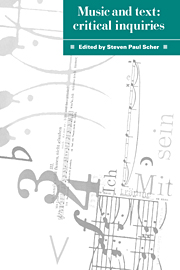Book contents
- Frontmatter
- Contents
- List of figures
- List of contributors
- Preface
- Acknowledgments
- Part I Institutional dimensions and the contexts of listening
- Part II Literary models for musical understanding: music, lyric, narrative, and metaphor
- Part III Representation, analysis, and semiotics
- Part IV Gender and convention
- 12 Whose life? The gendered self in Schumann's Frauenliebe songs
- 13 Operatic madness: a challenge to convention
- 14 Commentary: form, reference, and ideology in musical discourse
- Index
12 - Whose life? The gendered self in Schumann's Frauenliebe songs
Published online by Cambridge University Press: 04 September 2009
- Frontmatter
- Contents
- List of figures
- List of contributors
- Preface
- Acknowledgments
- Part I Institutional dimensions and the contexts of listening
- Part II Literary models for musical understanding: music, lyric, narrative, and metaphor
- Part III Representation, analysis, and semiotics
- Part IV Gender and convention
- 12 Whose life? The gendered self in Schumann's Frauenliebe songs
- 13 Operatic madness: a challenge to convention
- 14 Commentary: form, reference, and ideology in musical discourse
- Index
Summary
Women have served all these centuries as looking-glasses possessing the magic and delicious power of reflecting the figure of man at twice its natural size.
Virginia Woolf[An ordinary woman] is the unutterable which man must forever continue to try to utter …
D. H. LawrenceFeminist scholarship in all disciplines has insisted on the study of cultural context, whatever the project at hand. This is because gender relations, while seldom brought to the surface for scrutiny in mainstream scholarship, are constructed by culture and are always among the most fundamental ideological structures operating in any society. It is part of the project of feminist work to keep pointing out, as a character in one of J. M. Coetzee's novels puts it, “how scandalously, how outrageously a meaning can take up residence in a system without becoming a term in it.” This is as good a description as any of my purpose here, to investigate how gender as a “meaning” resides in the Frauenliebe und -leben songs by Adelbert von Chamisso and Robert Schumann.
We have in these songs a particularly focused, not to say fraught, ideological situation. For one thing, because nineteenth-century listeners expected music to carry messages, the songs would have been understood in their own time to be doing “cultural work,” and indeed would have been used by their culture in ways that made that work explicit and gave social sanction to their message.
- Type
- Chapter
- Information
- Music and TextCritical Inquiries, pp. 219 - 240Publisher: Cambridge University PressPrint publication year: 1992
- 16
- Cited by



